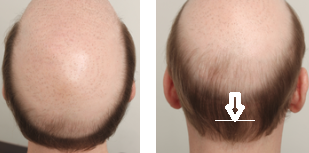What Is the Real Extent of the Donor Area Hair (Permanent Hair That Lasts Your Lifetime)?
The photo below shows a man with an advanced balding pattern (Norwood Class 7 pattern). This is the pattern that is a risk for every man having a hair transplant. Everyone runs this risk. They could lose all of their hair except for this 2½ inch rim of hair around the back and sides of the head. The white line shows where the neck hair begins and the arrow is 2½ inches long. The neck hair below the white line is not permanent hair. So if your surgeon takes hair above this rim area (where it is bald) or below the white line (neck hair) in any FUE surgery, you run the risk of eventually showing scars all over your head where the hair used to be before the balding happened. Not good!
This is why strip surgery is a better surgery for people with advanced balding patterns. If the density of this rim hair is good, then the area immediately above the white line can be harvested over and over again, decreasing the density of this rim with each successive harvest. I have harvested as many as 10,000 grafts from this rim in Class 7 patients and still left enough hair to keep the rim area covered when the density was very good. I have also been able to harvest routinely 6000-7000 grafts in people with average donor hair densities. If this area is harvested with FUE, the surgeon must stay away from the upper border or the FUE scars would show as balding progressed (https://newhair.com/donor-area/). The depletion of the donor area with FUE is not uniform so the number of grafts taken from this area is more limited than with the strip which is always harvested and re-harvested just above the white line if the surgeon does it correctly. The density of the residual hair after a strip surgery is always uniform. Of course, the scarring risk from repeated strip surgeries is real, but because there is always hair above the scar and Scalp Micropigmentation can address the scar so this is a manageable problem if it should happen (https://scalpmicropigmentation.com/scar-covering/).
The other important issue is the size of the bald area, which in this man is 80% of the original hairy scalp. So, this rim must supply hair to cover the entire bald area. The math is a real challenge and that is why your surgeon must be both an artist and a mathematician. Your surgeon must calculate what you need now and what you might need later as your balding progresses. This donor area is limited to about 50% of the original donor density. EVERY balding man will develop more hair loss over time, so a great surgeon understands this and should always be able to give you a status report of your reserves for future hair loss. Maybe you will not progress to a Class 7 pattern but rather a Class 6 pattern as only 7% of the population ever progresses to a Class 7 balding pattern. Poor planning by the doctor or patients who are in a rush to satisfy their immediate goals (particularly when they are early in the hair loss process) at the expense of your future needs, is not good. You and your surgeon must always develop a Master Plan for your future hair loss. Always think long term so that your decisions will be calculated to address the problem you have now and the problem that you will almost certainly have in the future.


Reader Comments0
Share this entry
Leave a Comment
Want to join the discussion? Feel free to contribute! Note: We do not tolerate offensive language or personal attacks to other readers. Marketing links or commercial advertisements will be deleted.